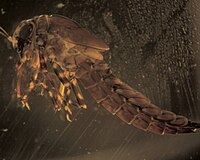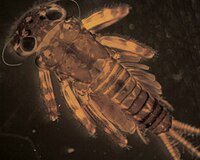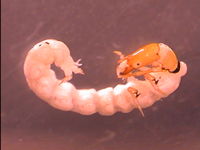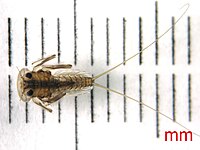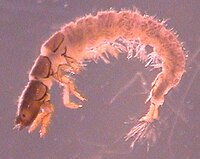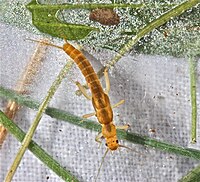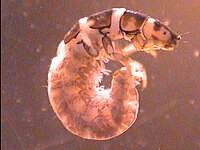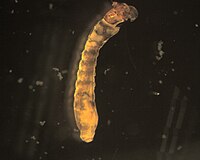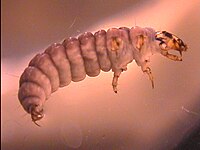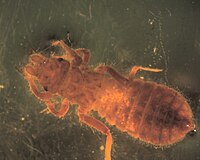Vermont EPSCoR's Streams Project; A Teacher Collaboration on WikiEducator
Openly shared content, practices, and developing resources from Vermont EPSCoR's Streams Project. Join this collaboration and make a difference!
 Lake Sunrise Outlet |
|---|
|
| Stream code: | LCC_HubbRv_439 |
| State or Province: | Vermont |
| Country: | USA |
| Latitude: | 43.75521 |
| Longitude: | -73.261367 |
This site was constructed for the nature program at Camp Sunrise. The following are the most common invertebrates collected from this stream site.
Isonychia
- Order
- Ephemeroptera
- Family
- Isonychiidae
- Genus
- Isonychia
- Common name
- The Dun Variant
- Tied fly
- Flick's Dun Variant
This mayfly has unique long hairs on its forelegs as the main distinguishing characteristic (allowing anyone keying to move through quickly). Carefully observe the limbs because such hair can be matted down and therefore hidden in preserved wet specimens. The body of
Isonychia is slim and "minnow-like" when observed dorsally. In specimens we collected, they were commonly brown and substantial in length and width as compared to the very common Baetidae.
Even when individuals are immature, closer inspection can reveal the setae on the forelegs.
Image of the long hair on its forelegs.
Chironomidae
- Order
- Diptera
- Family
- Chironomidae
- Common name
- Nonbiting midge
- Tied fly
- Griffith's Gnat
Midge larvae tend to be the most common macroinvertebrate at our sites. As with other Diptera, there are no true jointed legs. Chironomidae do have a pair of prolegs at each end and preserved individuals tend to curl into a 'C'. Identification past family requires slide-mounted heads. We have seen philopotamid caddisflies misidentified with the chironomids and we suspect that that happens when samples are being sorted from trays. Under a microscope, six prominent legs can be seen on members of the caddisfly family Philopotamidae.
More information on Philopotamidae.
Maccaffertium
- Order
- Ephemeroptera
- Family
- Heptageniidae
- Genus
- Maccaffertium
- Common name
- The March Brown
- Tied fly
- March Brown
This genus of
Heptageniidae is distinguished by its gills on the seventh abdominal segment, which are reduced to slender filaments. Gills on segments 1-6 are truncated.
Images of the slender filaments, and the truncated gills.
Chimarra
- Order
- Trichoptera
- Family
- Philopotamidae
- Genus
- Chimarra
Chimarra are distinguished from the other Philopotamidae by a prominent asymmetrical notch in the frontoclypeus as well as a prominent process on the femur which bears a single hair (seta).
Images of the asymmetrical notch and prominent process.
Heptageniidae
- Order
- Ephemeroptera
- Family
- Heptageniidae
- Common name
- flatheaded mayfly
- Tied fly
- Light Cahill, Wingless Pale Evening Dun
This family of mayflies can be characterized by their distinctly flattened heads and striking resemblance of the character 'Jack Skellington' from the movie 'The Nightmare Before Christmas.' This family can either have two or three cerci (tails).
Commonly encountered genera include:
Epeorus
Heptagenia
Maccaffertium
Rhithrogena
Cheumatopsyche
- Order
- Trichoptera
- Family
- Hydropsychidae
- Genus
- Cheumatopsyche
Cheumatopsyche has a
forked foretrochantin (as does
Ceratopsyche). The foretrochantin is the projection at the uppermost portion of the front leg closest to the head. The leg may need to be pulled away from the body to expose this feature.
Cheumatopsyche have a small or inconspicuous
pair of sclerites under the prosternal plate that are difficult to see. Contrast that with the
larger pair of sclerites found on Ceratopsyche. To access sclerites, it's best to gently pull the pronotum and mesonotum in opposite directions. Note: the large single sclerite is the prosternal plate.
Cheumatopsyche have only 2 types of
hair on the abdomen: long thin plain hairs and thicker club hairs, which are narrow close to the body and widen out at the distal end. Paired sclerites on the ninth abdominal segment are notched.
Leuctra
- Order
- Plecoptera
- Family
- Leuctridae
- Genus
- Leuctra
This family of stonefly is fairly slender by stonefly standards. The divergent wing pads are a helpful characteristic. Leuctridae are similar in overall shape to the Capniidae; however, Leuctridae often do not have pleural folds. If they are present, they only extend from abdominal segments 1-7.
Leuctra are recognized by abdominal terga with posterior fringes of short hairs and last few segments with longer hairs.
Image of the divergent wing pads.
Ceratopsyche
- Order
- Trichoptera
- Family
- Hydropsychidae
- Genus
- Ceratopsyche
Ceratopsyche has a
forked foretrochantin. The foretrochantin is the projection at the uppermost portion of the foreleg. The leg may need to be pulled away from the body to expose this feature.
Ceratopsyche have a
large pair of sclerites underneath the prosternum. Note: the large single sclerite is the prosternal plate. Biologists have gone back and forth between lumping this genus into
Hydropsyche and splitting it back out. ITIS currently lists it as a genus (Feb 2013) but we are aware of a recent paper that lumped it under
Hydropsyche.
Simuliidae
- Order
- Diptera
- Family
- Simuliidae
Simuliidae appear rather like bowling pins with heads. Relatively speaking, we collect few members of this family and have we have not identified them past family at this point.
Click here for a close up image of the heads.
Nigronia
- Order
- Megaloptera
- Family
- Corydalidae
- Genus
- Nigronia
Members of the genus
Nigronia share some superficial commonalities with Trichoptera, but on careful inspection one can see the two pair of anal claws that help place it in the order Megaloptera. The size of mature larvae is impressive; specimens from other genera exceed 8 cm in length. The abdominal segments have ribbon-like gills on the lateral portions. The mouth has mandibles that are serrated and used for biting prey. They can be confused with the more slender whirling beetle larvae; whirligig larvae also have simpler jaws.
Images of the two pairs of anal claws, whirligig beetle larvae and their simpler jaws.
Hydropsyche
- Order
- Trichoptera
- Family
- Hydropsychidae
- Genus
- Hydropsyche
- Common name
- spotted caddis
- Tied fly
- dark cahill
Hydropsyche are net-spinning caddisflies and share most characteristics with other members of the Hydropsychidae, including the
Ceratopsyche.
Hydropsyche are distinguished from
Ceratopsyche by the presence of scale hairs and minute spines on the three most posterior abdominal segments.
More information on the Ceratopsyche can be found here.
Image of the sclerites in the intersegmental folds.
Rhyacophila
- Order
- Trichoptera
- Family
- Rhyacophilidae
- Genus
- Rhyacophila
- Common name
- Green Caddis
- Tied fly
- Henryville Special or Glass Bead Caddis
In our lab,
Rhyacophila is known as the "Michelin Man" due to its large banded body. It has a very obviously checker-patterned head. It also has terrifying anal claws with large accessory hooks.
Links to images that may be useful if you have a magnifying glass or microscope:
Checker-patterned head.
Anal claws with large accessory hooks.
Gomphidae
- Order
- Odonata
- Family
- Gomphidae
- Common name
- clubtail dragonflies
Like other Odonata, members of this family have four wingpads. Like members of the sub-order Anisoptera, the abdomen terminates in five points. What distinguishes Gomphidae from Aeshnidae is the fact that Gomphidae has clubbed antennae.
Image of the four wingpads and the abdomen.
More information on Aeshnidae.

